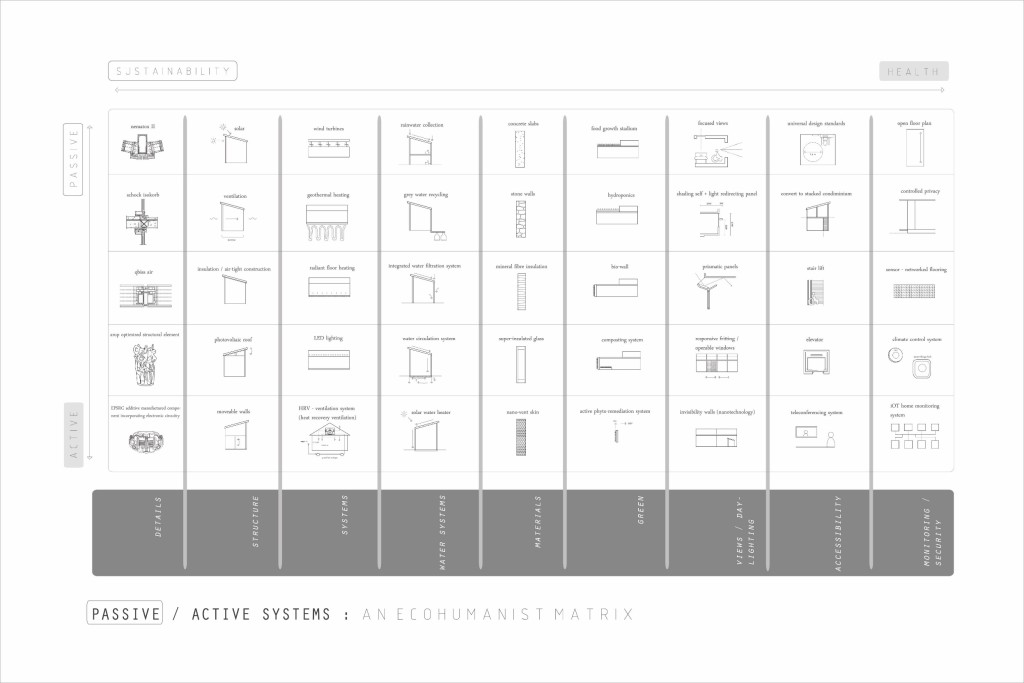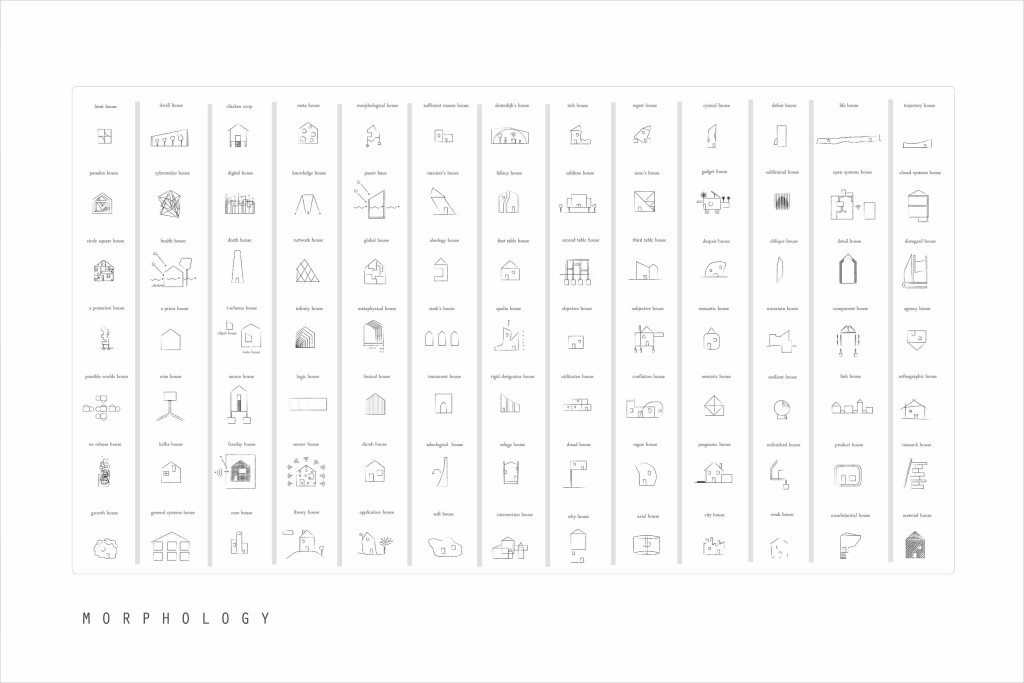PassivHealing
We are excited today to share a guest post by Nabia Majeed, on her thesis work at the University of Toronto around healing environments. Nabia participated in the Passive Building Show at Coolearth Architecture in the Fall of 2015.
Nabia Majeed is a Master of Architecture graduate from the University of Toronto who completed her thesis on healthcare architecture and palliative care. She is currently involved with design and planning projects at Toronto General Hospital, Princess Margaret Hospital, and Toronto Rehab as an employee of UHN Infrastructure.
In this post she looks into what qualities a “healing” environment has, and goes on to develop an approach around “user-centered” architecture.
PassivHealing by Nabia Majeed
A healing environment is considered to be:
A place to heal the mind, body, and soul
A place where respect and dignity are woven into everything
A place where life, death, illness, and healing define the moment, and the building supports those events or situations (Cynthia S. McCullough in ‘Evidence-Based Design for Healthcare Facilities’)
More specifically, a healing environment includes the following characteristics: thermal comfort, light, noise control, privacy, air quality, views of nature, visual serenity for those who are very ill, and visual stimulation for those who are recuperating. Initially it may seem that the PassivHaus Standard (also known as Passive House outside of Germany) has little to do with a healing environment – however, there is a great deal of common ground between the two.
PassivHaus Standard |
Healing Environment (Malkin, 1992) |
| Compact form and good insulation | Thermal Comfort |
| Southern orientation and shade considerations | Light |
| Energy-efficient window glazing and frames | Noise control |
| Building envelope air-tightness | Privacy |
| Passive preheating of fresh air | Air Quality |
| Highly efficient heat recovery from exhaust air using an air-to-air heat exchanger | Views of Nature |
| Energy-saving household appliances | Visual serenity for those who are very ill |
| Less than 15kWh/m2/yr total energy demand for space heating and cooling | Visual stimulation for those who are recuperating |
As seen in the table above, of the eight characteristics of a healing environment, several factors are also attributed to PassivHaus design: air quality, thermal comfort, noise control, and light. When a PassivHaus home is built with compact form, good insulation, energy-efficient window glazing and frames, and building envelope air-tightness, it is simultaneously conserving energy as well as providing thermal comfort and a healing environment for its inhabitants. The orientation of a PassivHaus ensures a strong amount of healthy daylight, both reducing heating costs and preventing tangible sickness such as Vitamin D deficiency and Seasonable Affective Disorder. The excellent insulation and air-tightness of PassivHaus buildings can also result in noise control of surroundings, providing the quiet peace of a healing environment. The passive preheating of fresh air in a PassivHaus further ensures a strong level of air quality required of a healing environment.

[Figure 1: Passive / Active Systems: A Sustainability and Health, Eco-humanist Matrix, Nabia Majeed, M.Arch Thesis]
The intersection between PassivHaus Standard and Healing Environments need not stop here – many other passive energy and sustainable strategies also simultaneously fall under the existing characteristics of healing environments, and also further expand the territory of health design. Listed below are a few examples:
-
Green walls, bio-walls, gardens:
air quality, views of nature, visual serenity for those who are very ill / palliative
-
Greenhouses, food-growth stadiums, composting (i.e. UHS unit), hydroponics:
air quality, visual stimulation for those who are recuperating, therapeutic activity for those suffering from mental illness, therapeutic activity for the elderly, retired or ill who may lack a sense of purpose, rehabilitative activity for those recuperating from illness resulting in disability
-
Heat Recovery Ventilators (HRV’s):
constant fresh air supply; less pollen, less allergies, less dust mites; helps limit and eliminate radon build up, quieter home as windows can be kept closed, no fungal or mould growth in bathrooms and bedrooms
-
Greywater Shower / Laundry System (i.e. Washit):
therapeutic, unrestrained use of relaxing, calming, pure activity of showering
-
Low VOC Eco-friendly Rubber Flooring:
breaking potential falls of the elderly / disabled
[Figure 2: The Urban Harvest Series (UHS) is a set artefacts and furniture that integrate nature’s closed cycles and cultivation into our own daily routines. Created by Design Academy of Eindhoven’s Sebastiaan Sennem, the unit allows people to grow, store, prepare, and compost organic waste, actively engaging them in a holistic and fundamental practice.]
Over time, the list of healing environment specifications has grown to include several other factors, including: access to nature, positive diversion (positive visual stimulation can lessen the stress of waiting times and improve the healing process), access to social support, options and choice (control), elimination of environmental stressors such as noise, glare, and poor air quality (McCullough). As new passive energy strategies and products emerge in our time, it is important to tie these innovations, or repurpose them, as contributions to healing environments, as applicable. This approach will ensure the creation of innovative passive homes effectively designed with the user in mind.
User-centered design is an important way to approach PassivHaus and Healing Environments –when the home becomes a product with a user, the design of the home should reflect the needs of the user. Users in 2016 and beyond will look for homes that conserve energy and reduce energy costs, but they will also seek out more from their dwellings: homes that are conducive to their own health and the health of their partners, children, and their elderly family members.
[Figure 3: A diagram from Humanscale 1/2/3: A Portfolio of Information, the definitive guide to the human body by Henry Dreyfuss Associates, part of the CCA-curated exhibit Imperfect Health.]
The HumanScale system of measurements is an example of the approach PassivHaus may consider in its approach to home-building – as designers are building PassivHaus homes or creating energy-saving products, they need to continually circle back to the individual, and ask how users will eventually engage with these spaces, strategies, and products. There are many types of users: human beings with a range of age and culture; people with distinct sizes and abilities; individuals with different professions and occupations; and persons of varying levels of health and well-being, both physical and mental. Comprehensive Healing Environment strategies, many of which overlap with PassivHaus standards, possess the potential to give new purpose, fresh direction, and innovative use to the PassiveHaus Standard.
The principles of PassivHaus could readily expand to include passive homebuilding standards conducive to healing and health, and in this way design and build homes that create an energy-conserving, safe, healthy and ideal user experience. This experience could in turn decrease accidents, injuries, illnesses, fatigue, stress, absenteeism, turnover, and general health costs experienced by both the individual and the health system at large. Studies show increased positive outcomes for home healthcare patients, and slightly decreased readmission rates and mortality rates compared to hospitalized patients. Satisfaction levels are recorded as 10% higher with reduced cost of care due to shorter lengths of stay in patients returned to their home environment, as compared to hospitalized patients (Cryer et al., 2012). Further, studies have also shown home healthcare to result in a 38% reduction in mortality compared to hospitalizations (Shepperd et al, 2009).
As advancements in healthcare prolong lives, but cures to diseases and illnesses lag behind, homes will need to be designed to serve as safe healing environments for a growing number of aged and ill people. The joining of PassivHaus Standards with Healing Environment standards could serve as the impetus to design innovative therapeutic, rehabilitative, and palliative homes that improve health outcomes for patients, reduce strain on healthcare facilities and the health system at large, and ultimately serve as healing environments for people, their families, and the environment itself.
[Figure 4: The formal design concepts relating to this spectrum remain ambiguous – morphological explorations of form complement the technical matrix of smart building (Figure 1) to further possibilities and to begin to forge a new eco-humanist design impetus; Nabia Majeed, M.Arch Thesis]



